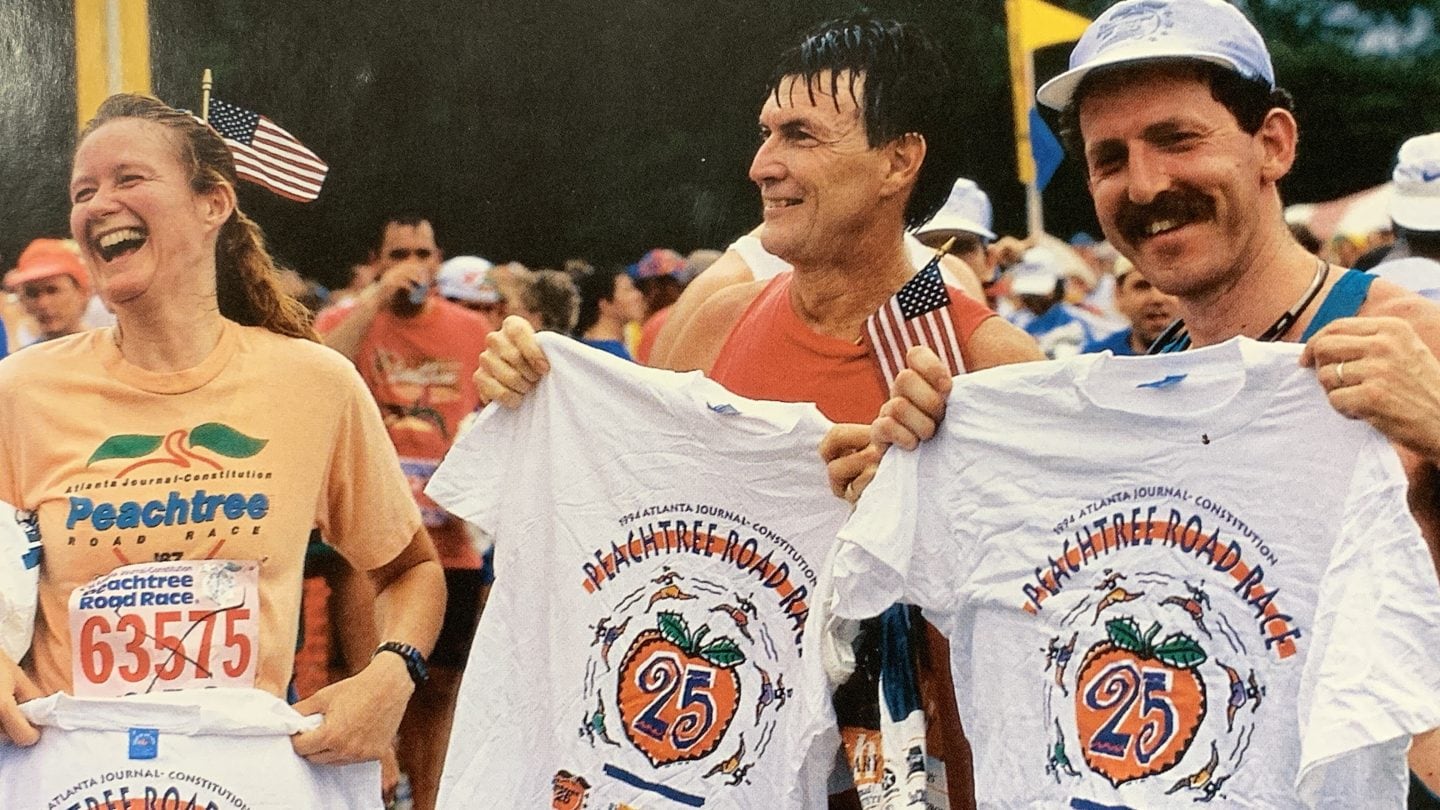
The 25th anniversary t-shirt caused such an uproar that Atlanta Track Club established a design competition so that the public could have their say.
The shirt. There is nothing more coveted. There is nothing more hated. There is nothing more anticipated. The AJC Peachtree Road Race finisher’s shirt is annually the most discussed, debated, and celebrated tradition of the world’s largest 10K.
And like almost everything about the Peachtree, how it was born and how it evolved is the stuff of legend. “It happened by accident, but we honored the accident,” said Julia Emmons, executive director of Atlanta Track Club from 1985 to 2006.
None of the “Original 110” at the 1970 Peachtree Road Race got a shirt. There wasn’t one. Finisher’s shirts weren’t a thing when the Peachtree started because road races weren’t a thing. Race founder Tim Singleton got the idea after he ran the Boston Marathon in 1971 and saw shirts for sale. So in the Peachtree’s second year, the first 250 finishers received a shirt.
The tradition of the Peachtree shirt began in 1971—when this shirt was given to 198 finishers.
In the beginning, the Atlanta Track Club and the AJC designed the shirts—and they weren’t given to every finisher. Shirts were awarded until they ran out. For the duration of the 1970s, the faster you were, the better shot you had a shirt. In fact, when the participant size swelled to 6,500 in 1977, more than half the entrants went home empty-handed. Today, every registered runner who crosses the finish line receives a shirt. The only commonality between today’s finisher’s shirt and the original is its importance to the recipient.
“The shirt is sacred,” said Emmons.
How sacred? Atlanta runner Jack Pearce, who ran 23 Peachtree Road Races, was wearing his shirt the day he was hit by a van while on a run. He spent eight days in the hospital. After he was released, Pearce and his wife went back to the scene of the accident and dug through the weeds and the mud to retrieve the shirt cut off of him by paramedics.
Keeping the t-shirt design a secret started out as an accident, too. There was simply no reason to take them out of the containers in which they arrived until race day, hence few eyes were laid on them before that morning. But it felt like a secret, and as curiosity and anticipation built up over the years, the Atlanta Track Club began to embrace—and intensely guard—the tradition of not revealing the design until the first Peachtree finisher crossed the line.
From 1985 to 1994, Emmons and her small staff at Atlanta Track Club worked with the marketing department at the AJC to create the design that would appear on the shirt. By that time, the design and color were closely guarded secrets, revealed on race day to predictably mixed reviews and met by strong feelings.
Sometimes, the feelings were largely shared. People loathed a sponsor logo on the back of the 1984 shirt (nothing ever appeared on the back of the shirt again), while the 1987 peach-colored shirt was a runaway hit.
Following the overwhelming backlash of 1994s “pumpkin debacle,”—when the public reaction was so strong the Atlanta Track Club received complaint calls for weeks—Emmons waved the white flag. “I said ‘That’s it. I’m not choosing it anymore,’” she recalled. And thus the AJC Peachtree Road Race launched their annual t-shirt contest.
The inaugural t-shirt contest finalists line up to show off their designs. The shirt on the far right won the competition.
For the past 25 years, the Atlanta Track Club has allowed the citizens of Atlanta to choose the winning design. There is no formula for creating the winning designs. American flags, footprints, shoes, and, of course, peaches are all popular. But cityscapes, street signs, and the occasional silhouette of a runner have also appeared in winning art. “Only think of two things—the gun and the tape,” said Sam Mussabani, whose design featuring a runner in full stride won the 1996 AJC Peachtree Road Race T-shirt Contest. “When you hear one, just run like hell until you break the other.”
Love the designs or hate them, Atlanta Track Club expects to spend nearly $400,000 on shirts for the 60,000 expected finishers this year.
While tweaks may be made here and there, the tradition of the t-shirt will likely last at least another 50 years. Its importance isn’t lost on the staff. No one on Atlanta Track Club’s staff will wear the finisher’s shirt. Why? They didn’t run the race. In fact, many learn of the winning design at the same time as the participants.
“It’s something people really care about,” said Emmons. “And you can’t let them down.”
